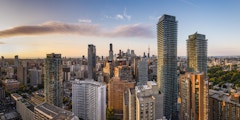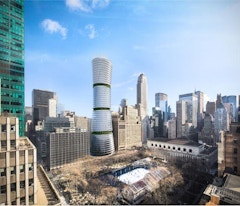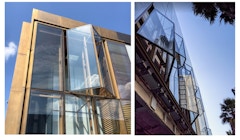199 results
-
How has the role of the façade evolved in light of the COVID-19 pandemic and ongoing fight to combat the climate change crisis? As companies grapple…
-

Window in Wall: Back to the Future
- Paper by Thomas Auer, Ata Chokhachian,
In order to get to a carbon neutral building stock – which is e.g. required by the EU Carbon roadmap by 2050 – our efforts need to be smart and… -

The Carbon Footprint of Aluminum Fenestration
- Paper by Tom Bougher · Richard Braunstein
The historical focus on reducing the carbon footprint of a building has recently shifted to include more emphasis on embodied carbon, the carbon
-

Event Passed
–2025 FGIA Southeast Region Meeting
- Clearwater Beach, United States
Industry Event by Fenestration & Glazing Industry Alliance
-

Separating Direct From Diffuse
- Paper by Nick Novelli, PhD · Robert Gordon · Igor Varfolomeev
An Enclosure-Integrated, Daylighting, Tracking Solar Collector (EIDTSC) has been developed for market which integrates into a building’s fenestration
-

Event Passed
Facade Tectonics Forum: TORONTO
- Toronto, Canada
The sold out 2019 Toronto Forum brought together AECO industry thought leaders to confront themes central to ever-evolving facade technology, themes engaging facade design, delivery, renewal, materiality, sustainability and resilience.
Forum by Facade Tectonics Institute, Inc.
-

-
Carbon-Neutral High-Rise Envelope Nexus
- Paper by Thomas Spiegelhalter, Principal
The pathway to carbon-neutrality, as urged during the COP 21 in Paris, and the repeated goal for resilient buildings and urban habitats, winds right… -

Orientation Specific Solar Control
- Paper by Clifton Fordham, Assistant Professor
During the postwar era, and before the universal adoption of air-conditioning in the United States, leading architects participated in the design of… -

Duplex Stainless Steel Cladding
- Paper by Fred Deuschle, Director of Engineering & Quality Jim Halliday, Director of Business Development
It was a challenging design problem: supply a sustainable material for roofing, soffit and fascia panels that would perform in close proximity to the… -

Academic Wood Tower Choreography
- Paper by John Peterson OAA FRAIC LEED AP BD+C · Leland Dadson OAA CPHD
With an ever-growing interest in mid- and high-rise mass timber construction, this paper highlights the insights and lessons learned across global
-

Event Passed
–FGIA Virtual Summer Summit
Industry Event by Fenestration & Glazing Industry Alliance
-

Hybrid Timber
- Paper by Stacey Hooper, AIA, LEED BD+C,
This case study provides an overview of building hybrid curtain wall system and future opportunities for the use of timber. It will also review the… -
Mapping Advanced Facades
- Paper by David Russell Lehrer · Vito Lamberti
This paper describes the development of an interactive map that highlights case studies of advanced facade design strategies and technologies from
-

Heat-actuated Auxetic Facades
- Paper by Amira Abdel-Rahman, Elnaz Tafrihi,
Highly transformable materials can be used as adaptive exterior shading systems by leveraging the relationship between external stimuli (heat) and… -

Multi Layer Facades
- Paper by Robert Moisy
The history of high performance facades and glazing has been a tale of attempting to manage the conflicting requirements of, on one hand inviting
-
Orbit Tower
- Paper by Enrica Oliva · Michele Andaloro · Werner Sobek
While most of high-rise buildings feature a core surrounded by a spatial frame defining the volume, one could envision a column-free plan where the
-
Translation from Concept to Construction
- Paper by Ryan Donaghy, AIA · Matthew Spahr, PE
Fidelity between the built enclosure and early visualizations is rarely, if ever, an accident. When achieved, it comes as the result of persistent
-
Glass in GSA Buildings
- Paper by Georgia Scalfano
Embodied carbon in buildings is a key factor in building decarbonization and while it is generally small compared to operational carbon, the
-

U-Factor Matters in Hot Climates
- Paper by Helen Sanders, PhD
It is commonly thought that fenestration U-factor is not a key determinant in the performance of facades in hot climates, and generally the focus of

